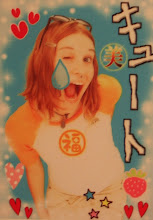 For this post I decided to talk a little about Nihon buyo, or one form of Japanese traditional dance. I chose to write about this because after seeing this particular show, I realized that this dance form is really both art and entertainment all in one. Also, after doing a little bit of research into the matter, I discovered that there are actually several different kinds of Japanese traditional dance forms, all of which are unique in some way or another. For example, some dances are done entirely by men, whereas other dances are done to describe some historical event. Today there are four traditional dances; Noh Mai, Bon Odori, Kabuki and Nihon Buyo.
For this post I decided to talk a little about Nihon buyo, or one form of Japanese traditional dance. I chose to write about this because after seeing this particular show, I realized that this dance form is really both art and entertainment all in one. Also, after doing a little bit of research into the matter, I discovered that there are actually several different kinds of Japanese traditional dance forms, all of which are unique in some way or another. For example, some dances are done entirely by men, whereas other dances are done to describe some historical event. Today there are four traditional dances; Noh Mai, Bon Odori, Kabuki and Nihon Buyo.

Although I can't be TOTALLY certain, I believe that the style of dance that these women were doing was Nihon Buyo, for they seemed to incorporate many different aspects into their dances such as fans, screens, props and even a weapon in one of them. Also the music (from what a friend and I could discern), was often telling a story that the women were both dancing to and "acting" out. Nihon Buyo combines aspects from Kabuki Buyo, Noh Mai, folk dancing and even some European/ Western culture. I could see aspects of all of these things in the dances. For example, it was done on a stage which comes from the Kabuki style theatre, some of the music incorporated flutes and hand drums (Noh Mai), and then some of the dances were done to music that seemed to be made with electric guitars! I remember watching the dances and thinking how different each one seemed to be from the last, and this is what leads me to believe that these dances were part of the Nihon Buyo style dance.

Also, I would like to mention briefly that the audience was almost completely made up of elderly women; I hardly saw anyone there who was younger than 40. Even the women who were dancing in the show were older (with the exception of a very young girl who did a dance by herself). I thought that to be quite interesting and also associated this with Kabuki because Kabuki theatre tends to attract an older audience. I'm not sure if my observation is correct, but either way, it was interesting to watch this show unfold.
**Check this out: it is selection from a book which uses Japanese traditional dance as an ethnographic case study that explores how movement is transmitted and embodied through dance. Unfortunately, in order to access selections from the book (the link I gave doesn't work), you must first go to google and type in book search. Then, when the search bar comes up, type in: Sensational Knowledge: Embodying Culture through Japanese Dance.

1 comment:
Interesting post. I am especially interested in the gestures used in Japanese traditional dance. Thanks for the info on the book. NHK has a show every Saturday afternoon (in Japanese and English) on various Japanese tradtional dance and theater.
The font color in your second to last paragraph is difficult to read...
Post a Comment